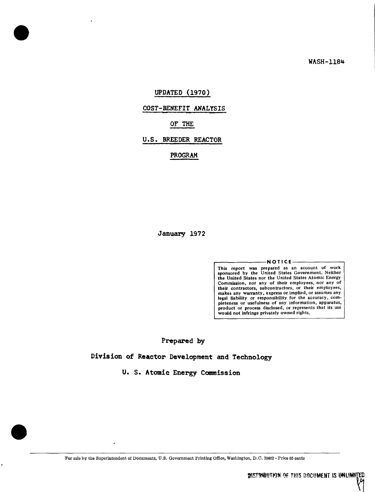WASH-1184 and the Reactor That Actually Worked: A 1970 Cost Analysis of the Molten Salt Reactor Experiment
How a 1960s experiment at Oak Ridge National Laboratory proved the economic feasibility of the molten salt reactor concept—and why the world is only now catching up
EGENERATION LIBRARY
👥 Authors
The document was prepared by:
Oak Ridge National Laboratory (ORNL)
Under contract with the U.S. Atomic Energy Commission (AEC)
As part of the Molten-Salt Reactor Program (MSRP)
Contributing authors and technical leads included:
Haubenreich, P.N. – one of the project leaders of the MSRE
Engel, J.R. – key contributor to reactor operations and performance evaluation
These individuals played leading roles in the design, construction, and operation of the Molten Salt Reactor Experiment (MSRE) conducted at ORNL in the 1960s.
🧪 Summary
Title: WASH-1184: The Molten-Salt Reactor Experiment – Description of Equipment and Experimental Results
Published: March 1971
Prepared by: Oak Ridge National Laboratory, under the Atomic Energy Commission
This landmark technical report provides a detailed description of the Molten Salt Reactor Experiment (MSRE)—a fully operational liquid-fueled reactor built and run at ORNL between 1965 and 1969. It was a proof-of-concept to validate the feasibility of using molten fluoride salt as both fuel and coolant in a thermal-spectrum nuclear reactor.
Core Highlights:
🔧 Reactor Design and Function
MSRE was a single-fluid, graphite-moderated thermal reactor using LiF-BeF₂-ZrF₄-UF₄ as the fuel salt.
Operated at 650°C, utilizing Hastelloy-N for structural components to withstand corrosion.
Demonstrated stable reactor control with strong negative reactivity coefficients, making it inherently safe against thermal runaway.
🔁 Fuel Versatility and Testing
Initially loaded with U-235, and later transitioned to U-233, making it the first reactor to operate with uranium bred from thorium.
Online fueling and minimal pressure operation reduced mechanical complexity and allowed continuous monitoring of system behavior.
📊 Operational Achievements
The MSRE ran over 13,000 hours without major incident, proving the viability of liquid salt systems.
Notable for its pioneering instrumentation, remote maintenance procedures, and continuous fission product removal via gas sparging.
Post-operation analysis offered critical data on salt chemistry, corrosion, tritium handling, and fission product management.
🧱 Material and Maintenance Insights
Long-term data on Hastelloy-N, graphite moderator behavior, and salt purity contributed to future MSR design improvements.
Remote servicing and shielding concepts were validated, influencing Generation IV reactor accessibility strategies.
Click on the document image to view or download the document!
💰 Salt, Steel, and Simplicity: The Economic Case Hidden in WASH-1184
“A good engineer makes things work. A great engineer makes things work affordably.”
— Unknown, but likely uttered at Oak Ridge, 1965
In 1971, a modest document titled WASH-1184 was released by Oak Ridge National Laboratory. It chronicled the birth, operation, and retirement of an engineering marvel: the Molten Salt Reactor Experiment (MSRE)—a machine that didn’t just work, but did so at a cost that should have revolutionized the economics of nuclear power.
Instead, the report was shelved. Its implications were ignored. And for the next 50 years, the world wandered through cost overruns, regulatory paralysis, and fission-fueled frustration.
But now, as nations scramble to decarbonize without destabilizing their economies, MSRs are making a comeback—and the economic lessons embedded in WASH-1184 are more relevant than ever.
🛠️ The Reactor that Proved Less is More
The MSRE wasn’t big. It didn’t generate electricity. It wasn’t surrounded by bureaucrats or PR stunts. It was a testbed—a functional molten salt reactor, run by scientists with slide rules, built with parts that would now be called "off-the-shelf."
Total cost of the program: approximately $10 million (roughly $80–90 million today, inflation-adjusted).
Time to completion: about five years from conception to criticality.
Operating hours: over 13,000, using both U-235 and U-233 as fuel.
Result: No meltdowns, no pressure vessel, no steam explosions, no radioactive containment breach.
In today’s energy investment terms, that’s pocket change—and a radically efficient use of resources. Compare that to the $10–20 billion-dollar price tags for many current Gen III+ light water reactor projects.
🧾 What Made MSRE Economically Elegant?
1. Low Pressure = Low Cost
Unlike pressurized water reactors (PWRs), the MSRE operated at atmospheric pressure. That eliminated the need for massive steel containment domes, complex pressure management systems, and redundant safety valves. The molten salt fuel itself was the safety system—expanding with heat, passively shutting down the reaction.
2. Fuel and Coolant in One
The fuel didn’t sit inside expensive, precision-machined rods. It was dissolved in the coolant itself. No cladding. No zirconium. No core reshuffling. This slashed material complexity and dramatically reduced the reactor’s internal volume.
3. Online Fuel Processing
No costly fuel fabrication plants. No multi-year shutdowns for refueling. The MSRE demonstrated the feasibility of on-site fuel cleanup, using sparging systems to remove gaseous fission products while the reactor was still running.
4. Modular Mindset
Though never commercialized, the MSRE hinted at what today’s engineers call modular construction: small, replicable systems that can be assembled on-site without sprawling custom infrastructure. This approach is now core to the business models of leading MSR startups.
🔁 Legacy in Today’s Reactors
Fast forward to the present. Companies like Terrestrial Energy (Canada), Moltex (UK/Canada), ThorCon (USA/Indonesia), and Seaborg (Denmark) are building reactors that echo the MSRE’s DNA:
Liquid-fueled or salt-cooled
Modular and factory-producible
Designed for passive safety and high thermal efficiency
Flexible in fuel sourcing (from thorium to spent LWR fuel)
These reactors are not fantasies. They are commercial projects, already in pre-licensing or early deployment stages, and many of them openly credit MSRE and WASH-1184 as their foundational inspiration.
In fact, DOE’s Advanced Reactor Demonstration Program (ARDP) is funding projects that revisit MSRE’s approach—implicitly acknowledging what should have been obvious decades ago: MSRs weren’t theoretical. They were tested and proven.
💸 The Real Cost of Ignoring WASH-1184
It’s tempting to ask, “Why didn’t we build more of these?” The answers—bureaucratic inertia, Cold War politics, fast-breeder funding bias—are as frustrating as they are familiar.
But the true cost wasn’t measured in wasted research grants. It was measured in:
Decades of inflated nuclear capital costs
Lost innovation cycles
Public disillusionment with the nuclear promise
Continued reliance on fossil fuels for base-load generation
Had the MSRE been scaled, iterated, and commercialized—like nearly every other successful energy technology—the world might now be running on small, cheap, safe reactors using abundant thorium instead of expensive enriched uranium.
🧠 The Future is Feasible (Again)
Today, with energy inflation surging, grid instability rising, and climate mandates looming, the economics of nuclear must change—or die. Light water reactors, though safe and effective, remain capital-intensive and slow to deploy.
MSRs offer an alternative that doesn’t sacrifice safety for cost. They offer economic elegance through engineering simplicity. And they offer the one thing every serious energy system needs: scalability without compromise.
WASH-1184 didn’t just document a successful experiment. It documented a pathway not taken—but still available.
📈 Conclusion: A Blueprint for Capital-Efficient Innovation
Economists often speak of “opportunity cost.” In the case of MSRE, the opportunity was abundant, affordable, secure nuclear energy. The cost of ignoring it has been immense.
But the future is not lost. From Oak Ridge to Copenhagen, from Jakarta to Calgary, the MSR blueprint lives on.
It was never a dream. It was a documented achievement—one we can still build on.
And this time, we have no excuse not to.


By Miranda Morrow




